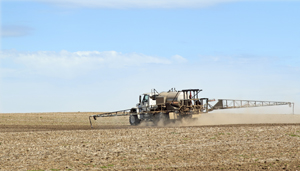High crop yields often come under scrutiny because of the fertilizer levels needed to produce such yields and because of the perception and reality of the potential environmental impacts of those inputs.
Yet, maintaining food production for the growing world population requires using new technology and intensifying production and management to grow more food on current cropland. Fertilizer is essential for accomplishing this.
Misuse of agricultural fertilizers have undoubtedly occurred, and its impact on the environment needs to be minimized. But it’s important to remember to compare the risk of fertilizer application with the benefits for food production.
The time has come to dispel misconceptions and myths about fertilizers and nutrients, and to convey a correct message to a world that’s becoming increasingly urbanized and removed from what agricultural production is all about – providing healthy food.
Fertilizers’ contribution to the food supply

A survey of U.S. crop production estimated that average corn yields would decline by 40 percent without nitrogen (N) fertilizer. Even greater declines would occur if other macronutrients, phosphorus (P) and potassium (K) were also limited. Numerous long-term studies have also demonstrated the contributions of fertilizer to sustaining crop yields. For example, long-term studies in Oklahoma show a 40 percent wheat yield decline without regular N and P additions. A long-term study in Missouri found that 57 percent of the grain yield was attributable to fertilizer and lime additions.
Similarly, long-term trials from Kansas show that 60 percent of the corn yield was attributable to fertilizer N and P.
Few people appreciate that corn yields have continued to increase in the Corn Belt of the United States without a similar increase in N (the nutrient addition most associated with runoff-related water impairment). In fact, N-use efficiency has increased at least 35 percent in the past 25 years (meaning less N fertilizer is now required to produce a bushel of grain). Remarkably, more corn is being harvested without increasing N fertilizer application rates. Some of this improvement has also come from modern genetics and improved agronomic management.
Is manure the answer?

Animal manure can provide a useful nutrient supply for growing crops. However, many people have the mistaken idea that manure has a special property for building soils. Manures contain no more nutrients than present in the animal feed that composes the manure. Similarly, manures don’t produce any organic matter that wasn’t initially in the animal feed. The digestion process doesn’t produce any additional nutrients or organic matter.
This means that whatever organic matter or nutrients are present in field-applied manure are simply digested crops from somewhere else. The hay, grain or silage that’s harvested to feed animals is simply taken from one field and then applied to another field after passing through an animal, with the inevitable loss of nutrients and carbon (C) to allow the animal to grow.
Animal manures rarely contain the essential plant nutrients in the proper ratio required for growing crops. In fact, certain types of manure application frequently result in imbalances and accumulation of nutrients in the soil that can pose an environmental risk. Composts and manures can be good nutrient sources, but their mineralization depends on complex interactions of both soil and environmental factors that are difficult to predict, which commonly results in a lower efficiency than fertilizer.
In an ongoing study in England (begun in 1840), applications of farmyard manure increased soil C and N to a greater extent than did fertilizer N. However, soil physical properties such as aggregate stability and water infiltration improved the most in the treatments receiving fertilizer N. The N leaching that followed the recommended manure application (75 tons per acre per year) was almost twice that from the fertilizer N treatment (250 N pounds per acre per year).
There will likely be more livestock and animal manure in the future, and these animals will consume more grass and crops that must be fertilized, and produce manure that must be managed. But the animals themselves will not provide the needed new nutrients. Expanding urbanization means more organic waste and biosolids to manage. But resistance to applying these materials back on the land seems to be growing, and their land application is banned in many countries.
Proper crop nutrition plays a vital role in maintaining the world’s food supply. Use fertilizer appropriately to get the best results, and don’t be afraid to speak out for farming practices that are such a benefit to humanity.
Source: Dr. Rob Mikkelsen, Director, Western North America Region, International Plant Nutrition Institute (IPNI)